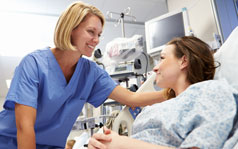Breast Reconstruction
Contact Us
Request an AppointmentPlease note that a referral letter is required before an appointment can be confirmed.
Please note that a referral letter is required before an appointment can be confirmed.
Useful Information
About our services
Breast reconstruction is an option for women who require a mastectomy. For some women, it helps them to feel more like themselves again.
Reconstruction can be done during the mastectomy surgery (immediate) or at a later date (delayed) after the mastectomy incisions have healed and breast cancer therapy has been completed. Delayed reconstruction can happen months or even years after the mastectomy.
The decision for this may be medically led, but usually is the patient’s choice. When carried out at the time of the mastectomy, it can avoid a second separate hospital procedure. At the same time, having the flexibility to choose to have the procedure at a later date allows you more time to come to terms with their diagnosis and to make associated decisions.
Women who choose to have their breasts rebuilt have options for how it can be done. Breasts can be rebuilt using implants (saline or silicone). They can also be rebuilt using autologous tissue (tissue from elsewhere in the patient’s body, known as a flap). Or they may be rebuilt using a combination of both implants and autologous tissue.
The DIEP flap procedure uses the patient's own tissue, and sometimes an additional implant. This method has many benefits, including fewer long-term complications like hernia or muscle weakness, and a lower chance of needing additional surgeries, especially when implants are not used.
When deciding on the most appropriate technique your consultant will take into account your medical details, any need for ongoing breast cancer treatment particularly radiotherapy, and any other personal issues relating to the patient.
Nipple reconstruction is usually carried out as a day case at a later date.
While no breast reconstruction will ever be perfect, the aim is to achieve a reasonable match to the opposite breast. However, it can sometimes be difficult to closely match the opposite breast. In these circumstances, your surgeon may discuss the option of surgery to the opposite breast to best achieve symmetry.
Implants are usually placed as part of a two-stage procedure.
In the first stage, the surgeon places a device called a tissue expander under the skin that is left after the mastectomy or under the chest muscle. This device is slowly filled with saline during periodic visits to the doctor after surgery.
In the second stage, after the chest tissue has relaxed and healed enough, the expander is removed and replaced with an implant. The chest tissue is usually ready for the implant two to six months after mastectomy.
In some cases, the implant can be placed in the breast during the same surgery as the mastectomy—that is, a tissue expander is not used to prepare for the implant.
Your medical team will watch you closely for complications. You may benefit from physical therapy to improve or maintain shoulder range of motion or to help recover from weakness in the area the from which the donor tissue was taken.
What factors influence the type of reconstructive surgery I can have?
Several factors can influence the type of reconstructive surgery chosen. These include the size and shape of the breast that is being rebuilt, your age and health, your history of past surgeries, surgical risk factors (for example, smoking history and obesity), the availability of autologous tissue, and the location of the tumor in the breast.
Does breast reconstruction affect the ability to check for breast cancer recurrence?
Studies have shown that breast reconstruction does not increase the chances of breast cancer coming back or make it harder to check for recurrence with mammograph
Your team
Breast reconstruction is carried out by a plastic or breast surgeon, as part of the multi-disciplinary team which includes the oncologist, radiotherapist and specialist nurses.
Our consultants in Dublin
/mr.-mitchel-barry-.png?sfvrsn=d438210d_1)
/mr.-kevin-cronin.png?sfvrsn=6a10c885_1)
/mr.-richard-hanson-.png?sfvrsn=a298f45c_1)
/prof.-malcom-kell.png?sfvrsn=43e38f38_1)
/mr.-dylan-murray-.png?sfvrsn=eb814fb_1)
Mr. Dylan Murray
Craniofacial/Maxillofacial, Plastic, Reconstructive & Aesthetic Surgery View Profile/prof.-maurice-stokes-.jpg?sfvrsn=9203297_1)
/ms.-siun-walsh.jpg?sfvrsn=8dadaef8_1)
Our consultant in Cork








.jpg?sfvrsn=bc97231b_1)


